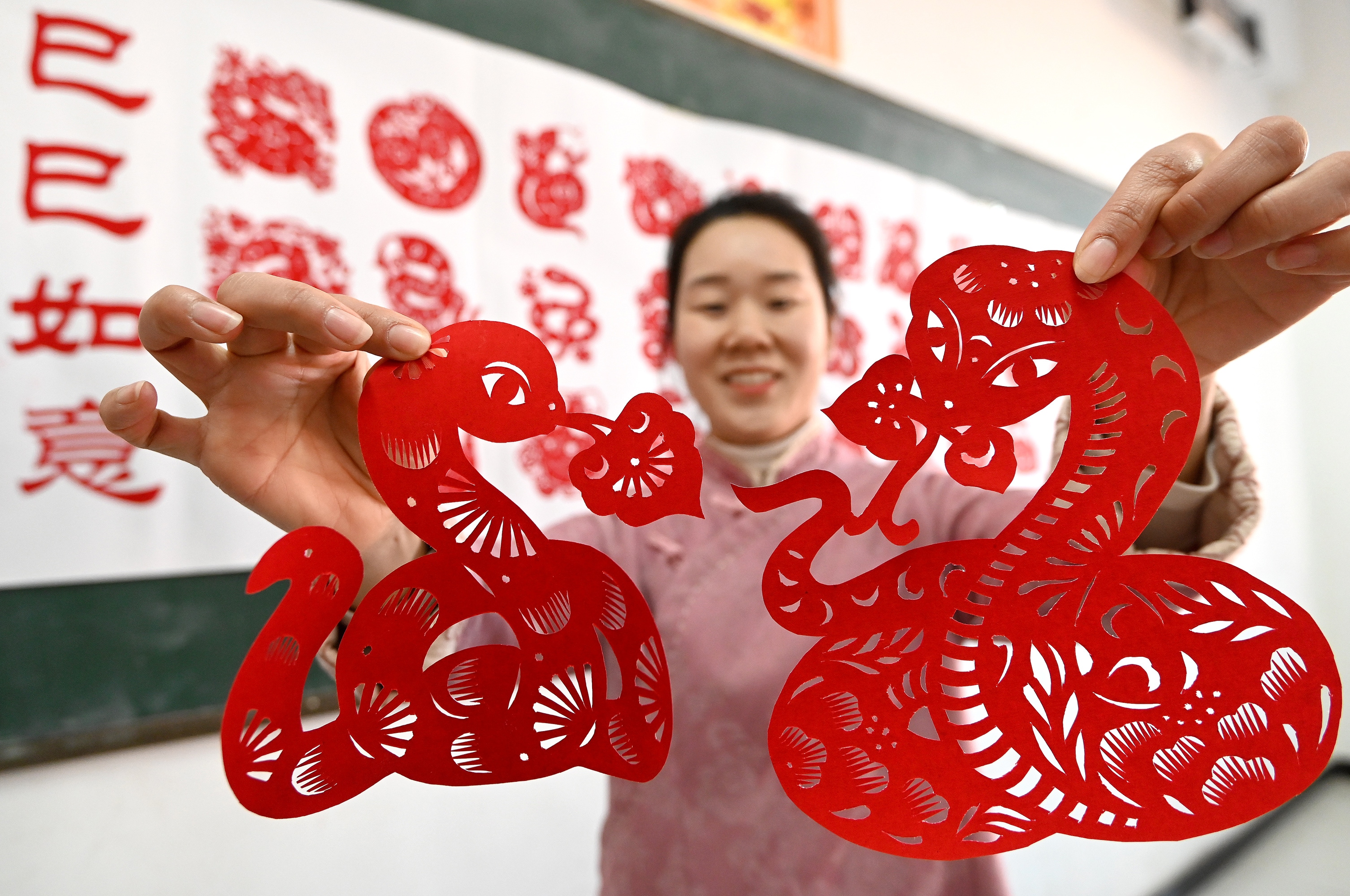What is Lunar New Year?
Lunar New Year, also known as Chinese New Year or Spring Festival, is a major festival celebrated at the beginning of the Chinese lunisolar calendar. Thought to have originated in ancient China around 3,500 years ago, it is one of the most important holidays in Chinese culture, marking the end of winter and the beginning of the new year.
The festival typically falls between 21 January and 20 February and is celebrated in the Sinosphere or the Sinic world (Chinese-speaking countries and regions, and countries and regions historically under Chinese influence), including mainland China, Taiwan, Hong Kong, Macau, Singapore, Vietnam, and Korea. Cultural traditions including chucheng (cleaning one’s house to remove dust and bad luck), decorating with lucky red items such as lanterns, papercuts and spring couplets (chunlian 春聯), giving and receiving red envelopes known as hongbao and eating auspicious foods with family make the Lunar New Year a special time that’s more than just celebration – the festival respects cultural heritage and unites families and communities in a spirit of renewal, optimism and hope for the future.
In 2025, the Lunar New Year will begin on 29 January.

What does the Snake symbolise in Chinese culture?
Interestingly, the metaphors and meaning of the Snake in Chinese literature and mythology are polar opposites. On the one hand, the snake belongs to the yin, associated with darkness, dampness and femininity. Poisonous snakes are often associated with evil women who seduce men and suck their yang to nourish their yin.
However, snakes also have positive symbolism. For example, they are regarded as little dragons (xiaolong 小龍), and the skin snakes shed is referred to as the dragon’s coat (longyi 龍衣), symbolising good luck, rebirth and regality. The snake also symbolises the pursuit of love and happiness, a theme beautifully illustrated in the traditional folk tale, ‘The Legend of the White Snake’. The snake can also represent wealth and wisdom, and in traditional Chinese culture, they are often grouped with the turtle and the crane as a symbol of longevity
Why is the 2025 Lunar New Year called Year of the Wood Snake?
The Chinese zodiac is a 12-year cycle that links each year to an animal sign. The 12 animal signs are Rat (shu 鼠), Ox (niu 牛), Tiger (hu 虎), Rabbit (tu 兔), Dragon (long 龍), Snake (she 蛇), Horse (ma 馬), Sheep (yang 羊), Monkey (hou 猴), Rooster (ji 雞), Dog (gou 狗) and Pig (zhu 豬). The order of the animal signs is fixed, with the Snake being sixth in the cycle, hence the Year of the Snake (shennian 蛇年) in 2025. Last year, 2024, was the Year of the Dragon (longnian 龍年) and 2026 is the Year of the Horse (manian 馬年). Each year also corresponds to one of the five basic elements (wuxing 五行) in Chinese cosmology, namely Metal (jin 金), Wood (mu 木), Water (shui 水), Fire (huo 火) or Earth (tu 土), creating a 60-year cycle.
Also forming the sexagenary cycle are the ten Heavenly Stems (tiangan 天干) and twelve Earthly Branches (dizhi 地支), each possessing different attributes. In 2025, the Heavenly Stem is Yi 乙, representing Wood, while the Earthly Branch is Si 巳, representing Fire, thus establishing the year of Yisi 乙巳. Therefore, individuals born in 2025 may be called ‘Wood Snake’ or ‘Fire Snake’ or ‘Wood Fire Snake’. The five elements interact with one another in a cyclical manner; as a result, Wood gives rise to Fire. This interconnectedness results in the Wood Snake exhibiting a notably complex personality, embodying traits of both Wood and Fire.

What are people born in the Year of the Snake like?
Wood symbolises growth, flexibility and tolerance, while Fire represents passion, vitality and brightness in Chinese culture. With this dual influence, Wood Snake individuals tend to exhibit resilient, courageous and positive personalities, allowing them to maintain the drive and confidence to persevere in the face of adversity. Possessing excellent interpersonal and social skills, they often emerge as leaders within their circles of friends. However, they may appear idealistic when confronted with pressure and challenges and can easily feel lost and confused, requiring the support and encouragement of those around them to regain their strength.

Wood Snake individuals are recognised for their keen insight and extraordinary intelligence. They can swiftly grasp the key points when addressing problems and make prudent decisions. This quality makes them comfortable in both the workplace and social situations, as they excel at creating opportunities and paving the way for themselves and others.
That said, the Snake is the most tenacious of the 12 zodiac animals, so those born in the Year of the Snake are also believed to be particularly enigmatic and uncanny. Some people perceive the Snake as sinister and intimidating due to their elusiveness. Traditionally, the Chinese regard people born in the spring and summer of a Snake year as the most powerful and positive, while those born in winter are seen as relatively quiet and submissive, as winter is the time for snakes to hibernate. Additionally, those born during good weather in a Snake year tend to be more optimistic and easily satisfied than those born in poor weather.
The years of the snake include: 1929, 1941, 1953, 1965, 1977, 1989, 2001, 2013 and 2025.

What are the taboos in the Year of the Snake?
In Chinese culture, each year associated with the Chinese zodiac carries its own set of beliefs and traditions, including taboos and lucky colours. These traditions, integral to Lunar New Year celebrations and the broader cultural practices throughout the year, guide behaviours and decisions to promote a year of prosperity and good fortune. Understanding and respecting taboos and colour significances can profoundly influence personal outcomes, according to Chinese beliefs. Taboos in the Year of the Snake include:
- Killing Snakes: During the Year of the Snake, it is a serious taboo to harm snakes, as such actions are believed to invite misfortune. Conversely, showing respect to snakes throughout their zodiac year can attract good fortune.
- Travelling West: According to Chinese cosmology, the East is associated with Wood, as detailed in the Shuowen Jiezi, an early second-century AD dictionary. The dictionary explains that the character for ‘East’ (dong東) combines the symbols for Wood (mu 木) and Sun (ri 日), symbolising the rise of the sun from the woods in the East. Given that the 2025 Year of the Snake is identified as the Year of the Yisi, with Yi representing Wood and Si representing Fire, those born in 2025 should favour the East over the West. Heading East is thought to be more auspicious and supportive of personal growth for Wood Snake individuals.
Wear red, green and gold for good luck
In Chinese culture, red is universally known as a harbinger of good luck. It is thought to repel evil spirits and misfortune. In 2025, this symbolism is particularly potent, as red is associated with Fire. It is believed that wearing red can help mitigate excessive Wood energy, thus maintaining balance and harmony between the elements.
For those born in the Year of the Wood Snake, green is the most auspicious colour for life. Green represents Wood, which corresponds to Yi, the second of the ten Heavenly Stems. In the framework of the Five Elements in Chinese cosmology, Wood nurtures Fire, which relates to Si, the sixth of the twelve Earthly Branches. Therefore, green can enhance the energy of individuals born in the Year of the Wood Snake, attracting good luck and favourable fortune into their lives.
Gold represents wealth and prosperity. It is another auspicious colour, especially in the Year of the Wood Snake, where Si also signifies Gold/Metal. This element correlates with the direction of the West. Therefore, using gold in decorations or wearing gold can attract positive energy, enhance financial prosperity and maintain a healthy balance between the elemental associations of the East (Wood) and West (Metal) in 2025.
The Lunar New Year will begin on 29 January in 2025. This marks the start of the Year of the Wood Snake.
Professor Xiaohuan Zhao is Professor of Sinology (Religion, Literature and Theatre) in the School of Languages and Cultures. He is also a member of the China Studies Centre and Sydney Southeast Asia Centre. Hero photo credit: AdobeStock
Media contact
Elissa Blake
Media Adviser


